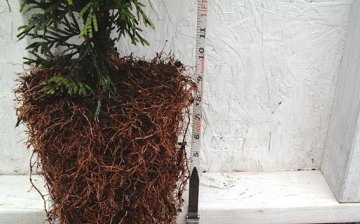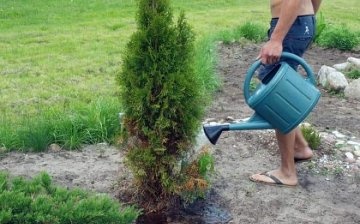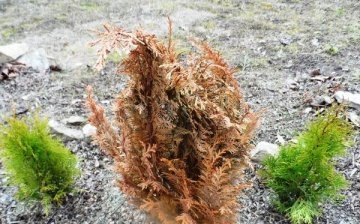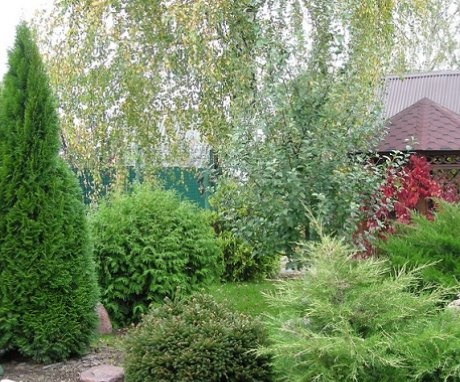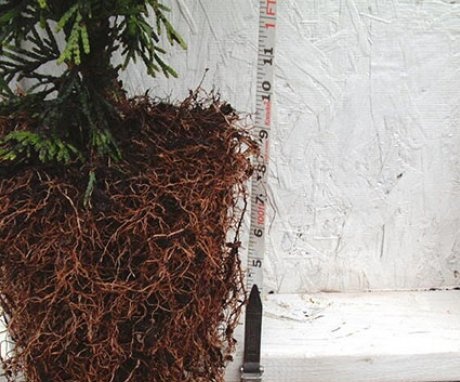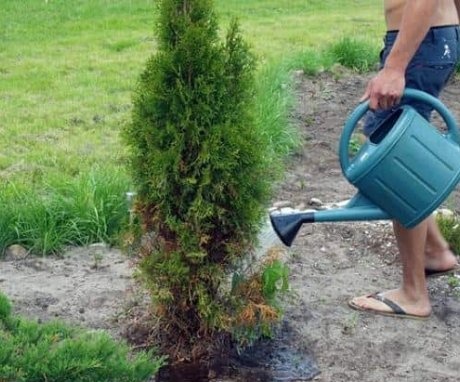Thuja root system: structure and care tips
In landscape design thuja takes the main place. Evergreen perennial is used to create hedges. Ephedra looks great in single and group plantings. By trimming the shrub, a decorative crown is created that matches the style of the site.
Thuja belongs to the Cypress family, has many varieties. On the plots, dwarf tree varieties and giants ten meters high are grown. And the crown of the thuja is diverse in shape, which allows the plant to be widely used to decorate the territory. When choosing evergreen conifers, thuja is preferred for its unpretentiousness to growing conditions and care. The decorativeness of the tree depends on the state of the root system of the plant.
Content:
- The best varieties and types of thuja for growing
- The structure of the root system of a coniferous plant
- How to properly care for the root system of a thuja?
- Possible growing problems, their solution
The best varieties and types of thuja for growing
Planting thuja on the site will be a wonderful resting place where you can stock up on vital energy, breathe in the aroma of a coniferous plant.
Depending on the shape of the crown, the types of plants are determined:
- Western thuja is characterized by high growth, reaching up to twenty meters, scaly needles.
- The Chinese type of tree is lower, but differs in a dense crown in the form of a pyramid.
- Thuja Korean is capricious. The creeping species is decorative, but grows best in warm climates.
- But the Japanese variety of ephedra is characterized by high adaptability to various climatic zones.
- Thuyu folded, or giant, is distinguished by a beautiful dense crown and growth from four meters and above.
- Thuja Brabant is considered the best varieties of evergreen tree. Its branched crown helps create a living barrier of trees, and not everyone can overcome it.
- Green cones of the Smaragd variety are good in a group, they firmly endure gusts of cold winds and winter frosts.
- The spherical crown of the dwarf looks interesting in the rock garden Tui Danica... From the Hoseri conifer variety, low hedges with a height of half a meter are original. And the width of the crown of the bush is sixty centimeters.
- I would like to note those varieties of wood that amaze with the color of the needles. In the Sankist, the needles of the conical crown are golden yellow, and in the folded Kornik, they are bright green.
A perennial tree is distinguished by small, scaly needles, which are tightly pressed against the shoots. The bark of many thuja species is smooth, reddish or gray-brown, depending on the variety. For the successful cultivation of thuja, you need to know what the structure of the root system is and how to care for it.
The structure of the root system of a coniferous plant
In order for a coniferous tree to develop, give an annual growth, it is necessary to provide favorable conditions for root system plants. In all types of thuja, the roots are branched and are located horizontally to the surface of the earth, without burying deep.
To make the root system of the tree compact, the shrub is first grown in containers.
Although it is difficult to separate the roots from one another during transplantation, a closed root system does not take up much space on the site. The plant prefers to be placed in fertile soil.Then there will be enough substances for the growth of thuja, and the crown will become fluffy and bright in color of the needles.
The success of growing ephedra depends on the conditions in which its branched roots are located:
- The closed root system assumes planting in April or October with the placement of thin roots in bags, containers. The roots are provided with drainage by pouring expanded clay, broken brick or pebbles on the bottom of the planting pit. The soil contains peat and sand. When planting a bush, do not forget that the root collar should not be below ground level. When the neck deepens, the thuja will die. When planting thuja for the hedge, they dig a trench, placing the roots of each plant in it compactly.
- With an open root system, the tree is naturally located in the ground. But then it is better to plant thuja in the spring, so that the perennial grows stronger over the summer and autumn and steadfastly endures the winter. Depending on the type of thuja, shrubs are planted at a distance of one to three meters from each other. This will allow the root system to grow freely.
How to properly care for the root system of a thuja?
The care of the root system must be taken responsibly so that the tree retains its decorative effect:
- Thuja roots need moisture, which comes in every three to four days in the amount of ten liters of water.
- Loosening the soil will increase air access to the plant. The soil is loosened to a depth of no more than ten centimeters.
- To ensure the safety of the roots, a layer is poured around the tree sawdust or peat.
- Weeds are weeded in order for the tree to fully develop.
- On poor soils, thuja requires top dressing mineral complexes... It is useful to mulch plantings with fallen needles and peat.
- For young trees, it is necessary to protect the root system from frost damage. To do this, cover the conifers with sacking of medium thickness. For mature plants, protection is not necessary.
In order for the plant to grow magnificently, the roots of the thuja are provided with moisture, air, and nutrition.
Possible growing problems, their solution
Many types of thuja are frost-resistant, so if the needles turn brown in winter, then this is a natural process. It will turn green in the spring. If this did not happen, then, most likely, the roots were exposed to low temperatures.
Lack of nutrition in the soil affects the condition of the tree. Do not place the roots of the tree in sandy soil, as the moisture will go deeper, causing the roots to dry out. It is difficult to fully develop in clay soil due to lack of oxygen. Areas with stagnant water will lead to decay of the root system. The ideal soil would be well-drained, slightly damp. This is a mixture of sod land with the addition of sand and peat. The deepening of the root collar or its openness badly affects the appearance of the thuja. In both cases, the plant will start to wither.
In order for the root system to develop freely, the distance between tree plantings must be at least a meter.
Fertilizers for the plant are required in case of emergency. Their excess in the soil leads to drying of the tips of the shoots. But the lack of elements will also affect the condition of the thuja. If the needles have become red-purple, it is urgent to add fertilizers with phosphorus to the soil. The crown will turn pale due to the lack of nitrogen, it will turn yellow - from a lack of iron. You can get rid of the problem by adding the right substances.
The root system of a tree can be affected by urine from pets. We must try to protect the thuja from such damage. The roots are also affected by fungal infections. If the bark at the bottom of the trunk falls under pressure, then this is due to a tree disease. Roots are also affected by the larva of the weevil beetle, wireworm. To treat a tree, use a solution treatment Bordeaux mixture, and rot is eliminated by disinfecting the cleaned wounds with a solution of copper sulfate. Pests are fought by injections of Actellik into the bark.You can save a coniferous perennial from trouble by understanding their causes.
More information can be found in the video:





